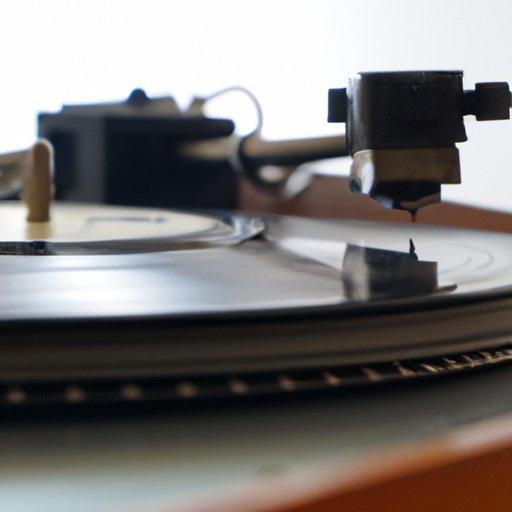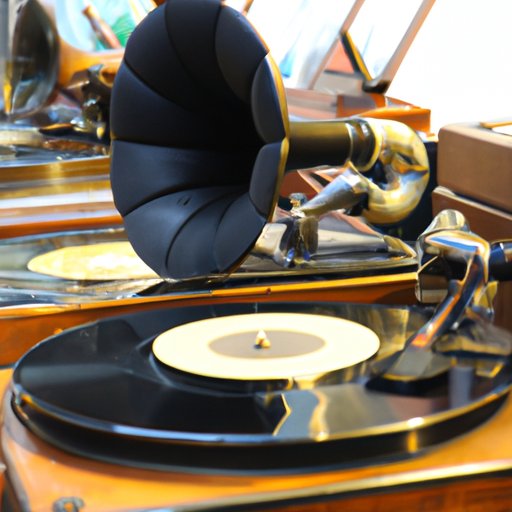Introduction
A record player, also known as a gramophone, is a device that plays sound recordings in the form of vinyl records. Invented in the late 1800s, record players have gone through many iterations, including the introduction of the electric motor, the development of the stylus, and improvements in audio recording technology. This article will explore the history of record player invention, from early phonographs and turntables to today’s modern record players, and examine how they revolutionized music and impacted music culture.

Historical Timeline of Record Player Invention
The first record player was invented in the late 19th century by Thomas Edison. His invention, called the phonograph, was able to record sound onto a rotating cylinder. Shortly after, Emile Berliner invented the gramophone, which was able to record sound onto flat disks made out of wax or cardboard. The introduction of the vinyl record in the 1930s further revolutionized the record player, as it allowed for longer playing times and higher quality audio.
In the 1940s, the modern record player was developed, with the introduction of the electric motor, the development of the stylus, and improvements in audio recording technology. These advancements allowed for the playback of recorded sound in a variety of formats, such as 78 rpm, 45 rpm, and 33 1/3 rpm. The advent of the modern record player marked the beginning of the popular music format, as well as the birth of the record industry.

How Inventors Revolutionized Music with the Record Player
The invention of the record player enabled people to play back recorded sound, which revolutionized the way people experienced music. Before the invention of the record player, music had to be performed live in order for it to be heard. With the introduction of the record player, people were now able to listen to their favorite songs whenever they wanted.
The invention of the record player also led to the development of the record industry. Record companies were established to produce and distribute vinyl records, creating a new market for music. This gave rise to popular music formats, such as 78 rpm, 45 rpm, and 33 1/3 rpm, which were then used to release popular songs and albums.
Innovative Technologies that Led to the Creation of Record Players
The invention of the record player was made possible by several innovative technologies. The introduction of the electric motor in the early 20th century enabled the record player to play back recorded sound without having to manually rotate the disk. Additionally, the development of the stylus allowed for the playback of recorded sound without damaging the vinyl record.
Finally, improvements in audio recording technology enabled the record player to accurately reproduce recorded sound. This included advances in microphone technology, which improved the fidelity of recorded sound, as well as the development of the equalizer, which allowed for the manipulation of recorded sound.

Exploring the Impact of Record Players on Music Culture
The invention of the record player had a profound impact on music culture. The ability to play recorded music opened up new possibilities for musicians, allowing them to create and distribute their music in a variety of formats. This led to the emergence of new genres of music, such as rock and roll, hip hop, and electronic music.
Record players also had an influence on fashion and lifestyle choices. In the 1950s and 60s, record players became a symbol of youth culture, and owning a record player was seen as a status symbol. Record players also became a popular accessory for home decor, and were often found in living rooms and bedrooms.
Finally, the invention of the record player helped to expand the music industry. Record companies began to focus on producing and distributing vinyl records, and record stores opened up to sell them. This helped to increase the popularity of music, and opened up new opportunities for musicians.
Pioneers of Record Player Invention: A Look at Their Contributions
The invention of the record player was made possible by several pioneering inventors. Thomas Edison invented the phonograph in 1877, which was the first device that could record and play back sound. Emile Berliner followed suit with the invention of the gramophone in 1887, which was able to record sound onto flat disks. Finally, Alexander Graham Bell developed the graphophone in 1886, which was an improvement on Edison’s phonograph and was the first device to use wax cylinders.
These inventors laid the groundwork for the invention of the modern record player, and their contributions are still felt today. Without their pioneering work, the record player would not exist, and the music industry would be vastly different than it is today.
Conclusion
In conclusion, the invention of the record player has had a profound impact on music culture. From early phonographs and turntables to today’s modern record players, the invention of the record player revolutionized the way people experience music. It also opened up new opportunities for musicians and helped to expand the music industry. As such, we owe a debt of gratitude to the pioneering inventors who made the invention of the record player possible.
(Note: Is this article not meeting your expectations? Do you have knowledge or insights to share? Unlock new opportunities and expand your reach by joining our authors team. Click Registration to join us and share your expertise with our readers.)
